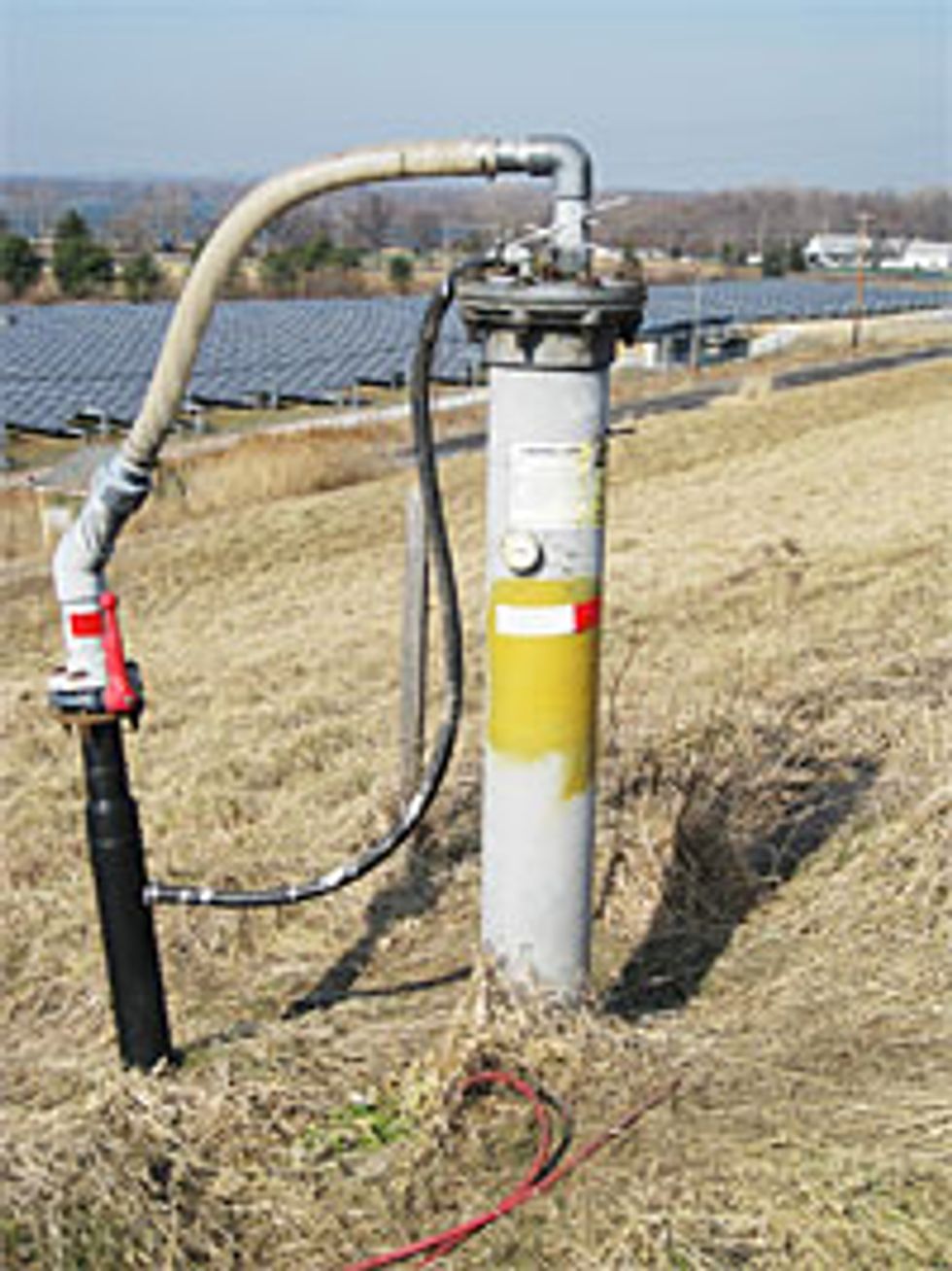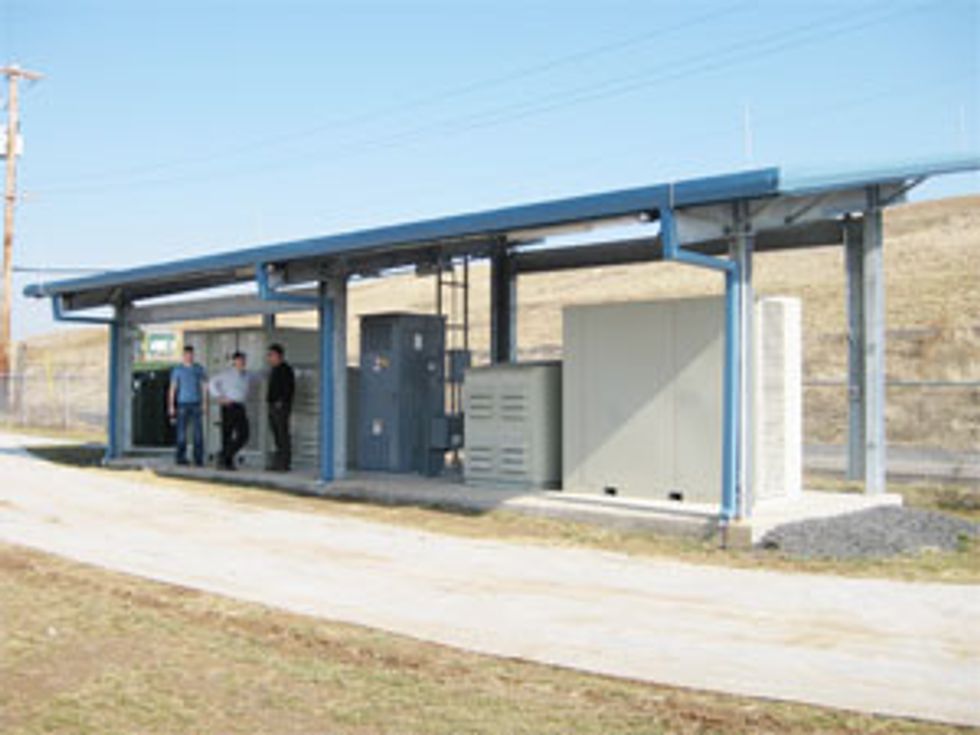31 March 2009—John F. Kennedy once famously described Washington, D.C., as having all the charm of a northern industrial city and all the efficiency of a southern town. When it comes to solar energy, something of the same might be said of the adjoining mid-Atlantic states: They have winter days that are almost as short as New England’s and summer days that can be as humid as South Carolina’s. Yet this past winter, nestled in a Delaware River landfill that’s somewhat of a mecca of renewable energy, the largest photovoltaic (PV) plant east of Arizona came into operation. It’s doing a nice job of delivering electrons into the Pennsylvania–New Jersey–Maryland grid (the PJM Interconnection), but at a cost that’s a little hard to make sense of.
A PV plant like this one, which was built in Pennsylvania’s Bucks County, subjects solar electricity to its toughest economic test. Photovoltaic electricity comes closest to paying for itself when it’s used in distributed situations—without connection to the grid—such as on the roofs of houses or office buildings. That way, it competes against the costs incurred by fossil-fuel and nuclear plants to both generate electricity and get it to the user. But when PVs are used to generate electricity centrally, achieving competitiveness is much more challenging. PV plants that link to the grid compete only on the cost of generation itself, because they incur the same transmission and distribution costs as generators running on fossil fuel and other nonrenewables.
The Bucks County plant, which consists basically of polysilicon modules assembled into arrays of panels, has the capacity to produce 3 megawatts—enough to power about 3000 homes. The modules were manufactured by the Chinese company Suntech, and the plant was built by the U.S. subsidiary of the German renewables integrator Conergy.
Beyond that, the plant’s family tree gets complicated. Shortly after building the plant, Conergy sold it to a bank, which in turn flipped it to another bank, but Conergy continues to operate the plant under contract with the second bank. That bank also has a 20-year electricity sales contract with Exelon Corp., owner of the local electricity distribution company, PECO. Exelon sells the electricity into the regional grid managed by PJM, the system operator, and, through PJM, markets the renewable energy credits (RECs) that it collects for supplying the solar electricity.
When we visited recently on a warm winter day, the plant was a surprisingly beautiful sight. It’s nestled in what’s called a retention basin—a water runoff area required in almost any new development—surrounded by rolling hills formed from municipal waste. Little pipes topping wells, part of a methane capture system, pop up like mushrooms from the hills, and thousands of migrating birds alight on them, attracted evidently by the smell of refuse. With the Delaware River in the background, it must be one of the world’s loveliest garbage dumps.
The little PV plant, covering 4.9 hectares is part of a rather new industrial park, which has been powered partly by the methane from the dump and now gets solar electricity as well. The development includes a plant that makes wind turbines and a polysilicon photovoltaics manufacturer, among other factories.
Green Gas
Well pipes dot the landscape of this landfill, collecting methane from the decomposition of refuse. The methane helps power an industrial park.
”There’s so much to commend [at this PV plant], in going to scale with a technology that so far has been used only in very limited applications,” says Kathleen McGinty. As Pennsylvania’s former head of environmental protection, McGinty fostered the development of renewables in the state and pushed along the Bucks County PV project, along with a companion 1-to-3-megawatt project at the Navy Yard in South Philadelphia.
Those involved in conceiving and designing the plant, notably Conergy’s Gary Sheehan and electrical engineering professor Peter Jansson, take obvious pride in their handiwork. They angled the rows of PV modules at 30 degrees with a southern orientation to optimize February and March photon capture, taking into account the need to withstand harsh winter weather and shed snow. (If the only objective were to maximize peak generation and collection of renewable credits, they’d be oriented more toward the west, explains Jansson, who teaches at nearby Rowan University, in New Jersey.) The modules are grouped in strings of 11 to build voltage, and the strings make up rows that can be disconnected independently, for maintenance.
So far, everything is humming along nicely, without actually making any noise at all or in any other way adversely affecting the surroundings. If the plant were built today instead of last year, boasts Jansson, it could be done at a cost of $5 per installed watt, which would be competitive with nuclear construction. Jansson, who was educated at MIT and the University of Cambridge, in England, points out that such PV plants can be built 10 times as fast as a nuclear plant without any of the concerns about local environmental effects, long-term waste storage, and weapons proliferation. ”From conceptualization to start-up, it took only about a year to build the PV plant,” says Jansson, whereas for a nuclear plant it would take more like a decade.
That’s a compelling point, but from a narrow economic point of view, it’s also a little misleading. A nuclear power plant, once built, can be expected to run full tilt for at least 40 years, producing electricity 90 percent of the time. A PV plant, in contrast, has a less-well-demonstrated life span and will generate electricity only about a third of the time. To compete economically with nuclear, it needs to be significantly cheaper to build.
Unfortunately, Conergy flatly refuses to say how much it actually spent to build the Bucks County plant, though the project has benefited from Federal and state investment and production credits. Exelon, for its part, refuses to say what it agreed to pay for the plant’s electricity over the 20 years of its contract with the owner.
High Voltage
Equipment turns the photovoltaic modules’ dc to ac to sell on the grid.
It stands to reason, McGinty points out, that the plant would not have been built if it couldn’t somehow pay its way. And what enables it to pay its way, she says, is the ”blended income stream” it gets for its electricity: One part comes from the value of the electricity itself; the other part comes from the sale of the RECs that are awarded to generators of renewable energy in the U.S. states that have adopted renewable portfolio standards.
The RECs—essentially subsidies given to suppliers of renewable electricity by consumers of nonrenewable energy—are the functional equivalent of the feed-in tariffs pioneered in Europe by Germany and Denmark. About half of the U.S. states have mandated that some proportion of generated electricity come from renewables by some date in the future, and a dozen of them—Pennsylvania included—have ”solar carve-outs,” that is, a special provision saying that some percentage must come from solar in particular.
The value of RECs is not trivial. Generally, those who sell renewable energy into the grid are given, free of charge, 1 REC per megawatt-hour of electricity supplied, which they can then sell on the open market. In recent months, in the general Bucks County operating region—Pennsylvania and New Jersey—Class 1 RECs (the kind the Bucks County station is eligible for) have been trading for between US $7.50 and $15.00. But solar carve-out RECs have been going for as much as $250.
During our plant visit, the hosts let slip that the plant is producing electricity at 30 cents per kilowatt-hour—at least triple the average generating cost of electricity in the Pennsylvania–New Jersey system. With solar RECs being sold locally at the equivalent of $0.25/kWh ($250/MWh)—which amounts to an almost fantastically high subsidy—you’d think it wouldn’t be too hard to make money from a plant like this one. After all, the seller of the electricity stands to get back 25 cents for every 30 cents it paid for the electricity (assuming that’s about what Exelon is spending).
Actually, says Michael S. Freeman, a senior originator with Exelon’s Power Team division, ”it’s a struggle. We haven’t sold all the RECs.” Freeman also points out that Exelon has to keep selling the RECs at good prices for the full 20-year duration of the contract. Though it was his idea to build the Bucks plant and he’s proud of that, ”it’s not easy to make money on solar,” he says.

